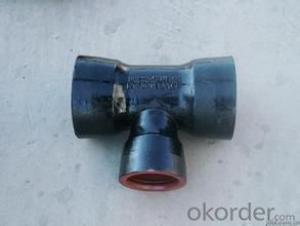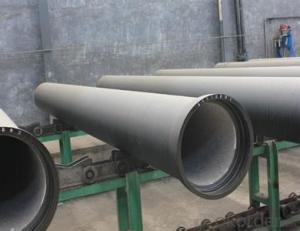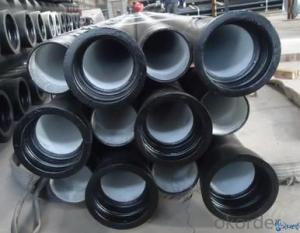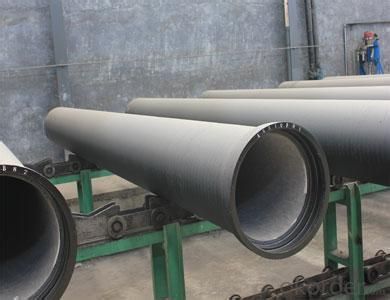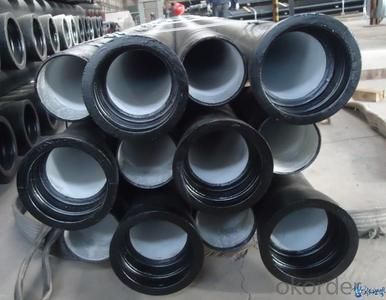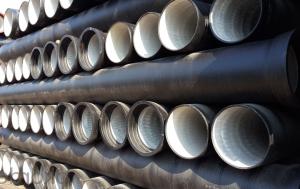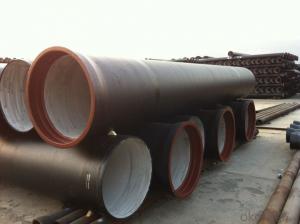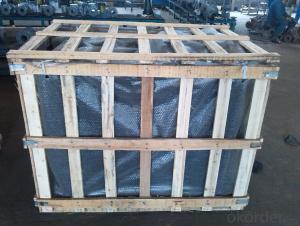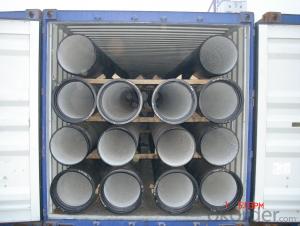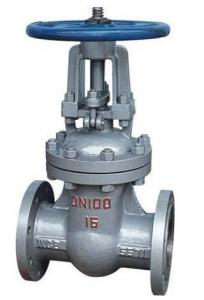DUCTILE IRON PIPE C Class DN700
- Loading Port:
- China Main Port
- Payment Terms:
- TT OR LC
- Min Order Qty:
- -
- Supply Capability:
- -
OKorder Service Pledge
OKorder Financial Service
You Might Also Like
Ductile Iron Cast Pipe is without any defects compare with tradition casting tech, which has many advantages particularly as follow:
(1) High density. In the "vertical upward casting" process, the melt iron of centre liquid column in center crystallizer is continuously feeding for volume shrinkage caused by condensation tube at outer circumference , which lead to be free of shrinkage porosity.
(2) High purity. When melt iron pouring, the mixed impurities such as gas, dross, sand grain which are lighter than melt iron could be eliminated at furnace mouth, its impossible to enter into the crystallizer through the channel, so the melt iron into the crystallizer is very pure.
(3) Strength with toughness. The cooling speed provided by continuous crystallizer is 30 times than sand casting and 5 times than centrifugal casting, and doesn't produce white iron, the eutectic cell volume of continuous cast iron is one eighth to one tenth compare with traditional cast iron. The density of graphite nodule in ductile iron can reach 300-700 pcs/mm2. Therefore, all reason above improve the strength and toughness of continuous cast iron.
(4) Free machining. The high speed cooling make the hardening phase (such as boride, steadite) not appear like reticular, massive or thick, but diffuse like fish bone and pane in shape, moreover, there are tiny graphite flakes inlaid hardening phase. It's free machining in BrinellHardness the range of 250-300HB. However, the Brinell Hardness of 250 is top limit to common metal materials.
(5) Uniform composition of tube wall. The convection mixing of liquid column caused by marching type drawing in crystallizer make the composition of tube wall well-distributed, and concentration gradient very little.
(6) High productivity. To the wall thickness of tube under 10mm, the speed of continuous casting is 1 meter/min, to the wall thickness of tube under 20mm, the speed of continuous casting is 0.5 meter/min, which is high efficiency that centrifugal or other casting tech couldn't reach.
- Q: What is the expected thermal expansion coefficient of ductile iron pipes?
- The thermal expansion coefficient of ductile iron pipes can vary due to several factors, such as the iron's specific composition and the temperature range of pipe usage. However, as a general rule, ductile iron pipes typically have a thermal expansion coefficient ranging from 10 to 14 x 10^-6 per degree Celsius (10-14 μm/m°C). This means that for every increase of one degree Celsius in temperature, the length of a ductile iron pipe will expand by approximately 10 to 14 micrometers per meter. It is important to acknowledge that these values are not exact and may differ depending on the specific circumstances and application of the pipes.
- Q: Principles for the antiseptic treatment of ductile iron pipes
- The principle that the antiseptic treatment of ductile iron pipes must be complied with is that.1. internal and external surface coating shall be kept clean, remove rust and impurities2. after coating on the inside and outside surface, the coating should be even and smooth, firm and firm, and shall not be abnormal because of climate change3. coating for water delivery should be insoluble in water, no peculiar smell, harmful impurities content
- Q: Are ductile iron pipes suitable for use in desalination plants?
- Ductile iron pipes are indeed suitable for use in desalination plants. Desalination plants are facilities that remove salt and other impurities from seawater, turning it into fresh water for consumption or industrial use. These plants require a reliable and durable piping system to transport the treated water to various destinations. Ductile iron pipes are known for their strength, flexibility, and corrosion resistance, making them an ideal choice for desalination plants. These pipes are made from a form of cast iron that has been treated with magnesium to enhance its properties. This treatment gives ductile iron pipes a high tensile strength, allowing them to withstand the high pressures associated with the desalination process. Additionally, desalination plants often use chemicals and other treatment methods to remove impurities from the water. Ductile iron pipes have excellent resistance to corrosion from these chemicals and can withstand the harsh conditions found in desalination plants without deteriorating over time. This ensures the longevity and reliability of the piping system, minimizing the risk of leaks or failures. Furthermore, ductile iron pipes have a smooth internal surface, which helps to minimize friction and pressure loss as water flows through the pipes. This feature is especially important in desalination plants, where efficiency is crucial for the overall operation of the facility. The smoothness of ductile iron pipes allows for efficient water flow, reducing energy consumption and optimizing the desalination process. In conclusion, ductile iron pipes are suitable for use in desalination plants due to their strength, flexibility, corrosion resistance, and smooth internal surface. These pipes provide a reliable and durable piping system that can withstand the high pressures, harsh chemicals, and demanding conditions found in desalination plants.
- Q: Are ductile iron pipes suitable for pressure sewer systems?
- Yes, ductile iron pipes are suitable for pressure sewer systems. Ductile iron pipes have been widely used in various applications, including pressure sewer systems, due to their high strength and durability. These pipes are able to withstand high pressure and provide a reliable and long-lasting solution for transporting sewage under pressure. Ductile iron pipes also have excellent corrosion resistance, which is crucial in sewer systems where they are exposed to various chemicals and contaminants. They are resistant to both internal and external corrosion, ensuring that the pipes remain intact and functional over time. Furthermore, ductile iron pipes have a smooth internal surface, which helps to minimize friction and improve the flow capacity of the sewer system. This ensures that the pipes can handle the required flow rates and prevent any blockages or backups. In addition to their strength and corrosion resistance, ductile iron pipes are also known for their ease of installation. They can be easily cut and joined using a variety of methods, making them a convenient choice for pressure sewer systems. Overall, ductile iron pipes are a suitable and reliable choice for pressure sewer systems due to their high strength, corrosion resistance, smooth internal surface, and ease of installation.
- Q: Are ductile iron pipes resistant to abrasion or wear?
- Indeed, ductile iron pipes exhibit remarkable resistance against abrasion and wear. Renowned as cast iron as well, ductile iron represents a robust and enduring substance exclusively crafted to endure abrasive circumstances. Ductile iron's distinct microstructure grants superb resistance to abrasion, rendering it an optimal selection for scenarios wherein pipelines face extensive levels of wear. Furthermore, the extended lifespan of ductile iron pipes showcases their enduring capacity against abrasion and wear throughout time.
- Q: Ductile iron pipe connection mode
- Main points of installation: (1) clean the pipe mouth: clean all the sundries in the mouth. Second, clean aprons, aprons on the adhesive material on the apron: clean up, put the ring bending "plum blossom" or "8" shaped into a socket groove, and hand along the entire ring press again, or with a rubber hammer, to ensure that each part of the warping apron is not twisted, evenly the card in the slot.
- Q: What are the differences between cast iron pipes W and A?
- W cast iron pipe is subdivided into W cast iron pipe and W1 cast iron pipe, the difference between them is the difference between the wall thickness. Because of the cold weather, the requirements for pipes are higher. The W cast iron pipes are mainly used in the north, while the W1 cast iron pipes are mainly used in the south.
- Q: What are the advantages of using ductile iron pipe over HDPE pipe?
- Ductile iron pipe offers several advantages over HDPE pipe. Firstly, it has a higher strength and durability, making it suitable for high-pressure and heavy-duty applications. Secondly, it has better resistance to external loads, such as traffic or soil pressure. Additionally, ductile iron pipe has superior fire resistance and is less susceptible to damage from UV rays. Moreover, it has a longer lifespan and requires less maintenance compared to HDPE pipe. Lastly, ductile iron pipe has better flow characteristics, resulting in lower energy consumption for pumping systems.
- Q: How much pressure can the ductile iron pipe socket meet?
- After all, he is not steel, strength is low, toughness is poor. But a short period of about 100kg, things should be no problem.
- Q: Can ductile iron pipes be used for gas distribution networks?
- Yes, ductile iron pipes can be used for gas distribution networks. Ductile iron pipes are known for their strength, durability, and resistance to corrosion, making them a suitable choice for various applications, including gas distribution. These pipes can withstand high-pressure environments and are less likely to crack or break under stress. Additionally, ductile iron pipes have a long lifespan, reducing the need for frequent replacements and maintenance. However, it is important to note that specific regulations and standards must be followed when installing ductile iron pipes for gas distribution, ensuring proper safety measures and compliance with industry guidelines.
Send your message to us
DUCTILE IRON PIPE C Class DN700
- Loading Port:
- China Main Port
- Payment Terms:
- TT OR LC
- Min Order Qty:
- -
- Supply Capability:
- -
OKorder Service Pledge
OKorder Financial Service
Similar products
Hot products
Hot Searches
Related keywords
